-Wiggys, the Home of
Lamilite
(Page is under development)
Mr. Jerry Wigutow claims that
his company is the largest manufacturer of sleeping bags in the
United States. His bags and other products all use "Lamilite,"
a synthetic, for insulation. Wigutow is outspokenly negative about
down insulation. His information-packed, lengthy website explains
why. www.wiggys.com
Wigutow remembers that he's met some of the major pioneers of
gear, including Gerry Cunningham, Roy and Alice Holubar, and Jack
Stephenson of Warm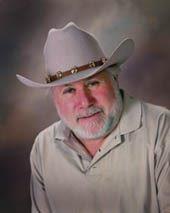 lite.
All three of these pioneers used down in their sleeping bags and
other products. Wiggy is 81*, and so was younger than these other
pioneers, but of these pioneers, only Jerry Wigutow is still living.
He's been based in Grand Junction, Colorado for many years. I
would love be able to post a picture of him from the 1970s, the
time period when he began selling his lamilite sleeping bags.
If anyone has a picture like that, please send it to me (brucej@Oregonphotos.com).
(*81 as of 2023). My picture of him is fairly current.
lite.
All three of these pioneers used down in their sleeping bags and
other products. Wiggy is 81*, and so was younger than these other
pioneers, but of these pioneers, only Jerry Wigutow is still living.
He's been based in Grand Junction, Colorado for many years. I
would love be able to post a picture of him from the 1970s, the
time period when he began selling his lamilite sleeping bags.
If anyone has a picture like that, please send it to me (brucej@Oregonphotos.com).
(*81 as of 2023). My picture of him is fairly current.
George Lamb* has been a special
friend of Wigutow. In fact, Wiggy's purchased the design of Lamb's
"Antarctic Parka," and that product is still offered.
I believe Wiggy's purchased other designs related to the sleeping
bags. (* Lamb started Alp Sport, then was involved with Alpine
Designs, and finally ran Camp 7; all three companies sold excellent
gear that was rated highly by such sources as Backpacker Magazine).
See my page: Alp-Sport1.html
*****************************************************************
Below is a picture of three sleeping bags: a Holubar "Royalight"
down bag with 8.5" of loft and rated to 20 below zero F.
I've talked to an ex-employee who described to me sleeping inside
a frozen meat locker in Boulder, Colorado. A very unusual job
duty, but one which Alice Holubar insisted upon.
The center bag is a Wiggys "Superlight" lamilite bag,
which has about 4.5" of loft. On their website, Wiggys rates
it to 0 degrees F. Mr. Wigutow generously gave me this bag to
test out. It is covered with a very lightweight ripstop nylon,
has a spacious cut, and is well-made.
The bottom bag is a North Face down bag named the "Chrysalis,"
rated by them to 25 degrees. It measures 4.5" of loft according
to my ruler.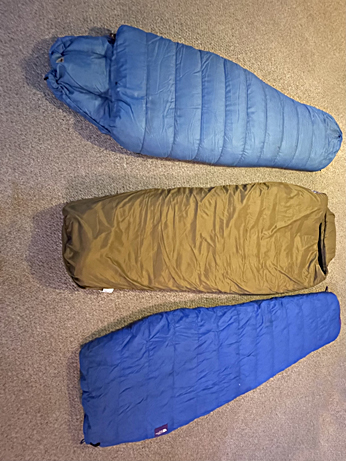 Re:
the Wiggys Superlight, I have never tried to sleep in it anywhere
close to its rated 0 degrees F. In fact, I am dubious of that
claim.
Re:
the Wiggys Superlight, I have never tried to sleep in it anywhere
close to its rated 0 degrees F. In fact, I am dubious of that
claim.
In the history of gear, sleeping bags have always been a major
product. Many companies have had their design innovations and
preferences.
Alice Holubar created in the mid-late-1950s what my research concludes
is the first truly backpack-able sleeping bag. Lightweight, filled
with down, and compactable enough to be backpacked into the wilderness
while capable of keeping the sleeper warm into late Fall and winter
conditions. Eddie Bauer's bags were close, but in my opinion not
as technically advanced. The Holubar bag shown above was sewn
in 1964 and still in fine shape.
******************************************************************
Loft vs. temperature ratings have always been a subject of great
interest to the buyers/users of sleeping bags, whether filled
with down insulation or synthetic insulations.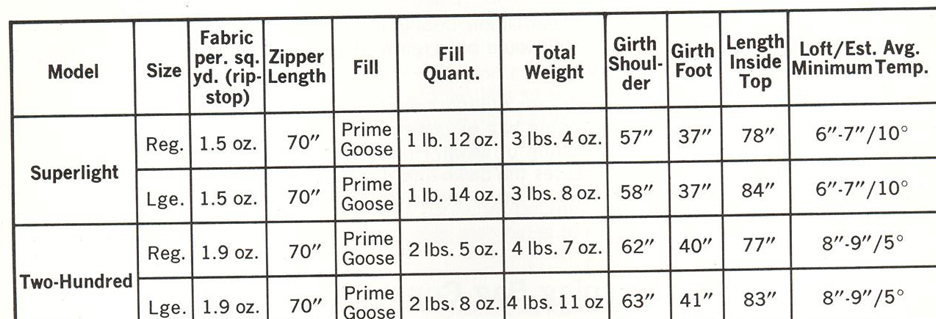 Above is a chart developed by major maker Sierra
Designs. It's taken from their 72-73 winter catalog. To Sierra
Designs a winter bag good to 5 above zero requires 8-9 inches of loft, as
in their model 200.
Above is a chart developed by major maker Sierra
Designs. It's taken from their 72-73 winter catalog. To Sierra
Designs a winter bag good to 5 above zero requires 8-9 inches of loft, as
in their model 200.
The Warmlite Triple bag (picture below) incorporates several really
big innovations. Jack Stephenson was an aerospace engineer and
was not afraid to throw out old ways of doing things.
Dry down is essential, this fact is well-known: In the big picture,
there have been three approaches to the issue: 1. Ignore that
consideration. 2. Throw out down entirely in favor of synthetics
such a Polarguard or Lamilite. 3. Use vapor barriers inside your
down bag to keep your body's insensible perspiration out of the
down, and, when necessary, add a waterproof top to keep exterior
moisture from wetting your down from above; eg. Frost falling
from the roof of ones tent. See the Warmlite SSS bag (Super Silver
Sleeper).
Gerry Cunningham's sleeping
bags were of standard construction: a breatheable nylon shell
and interior, and for insulation filled with goose down. Sierra
Designs, North Face, REI and others all used the same basic formula.
With the advent of Goretex in the late 1970s, some companies began
to use it for the sleeping bag exteriors. However, this did not
fix the issue of the large amount of water vapor that the human
body gives off constantly. Especially under extreme cold conditions
the body vapor would travel halfway through the down shell then
freeze, then the frost would get thicker each night you were out,
thus stealing much of the bag's warmth. Some companies added synthetic
insulations to their product lines (eg. Polarguard) because those
type of fibers were easier to dry off than down once the frost
problem would begin. But those sleeping bags were quite bulky
and heavier than comparable down bags.
As bag design entered the 2000s, various other synthetic fillings
entered the competition, each claiming special qualities; eg.
"softer and more comfortable." Meanwhile, Wigutow's
Lamilite had been in Wiggy's sleeping bags since 1975. The Wiggy's
website has extensive content about how Lamilite remains the best
in Wigutow's opinion.
www.wiggys.com
************************************************************************
The picture (below) shows a
Stephensons Warmlite "Triple Bag," their signature bag
model. It comes with two separate zip-on-zip-off down tops; when
used with both tops it's rated to about 30 below zero. I formerly
owned a Warmlite Triple Bag myself. Below:
a Warmlite "Triple" down bag with Red Top, Blue top,
gray vapor barrier liner....The yellow object is the DAM-- it's
a 4 inch thick "down-filled-air-mattress."
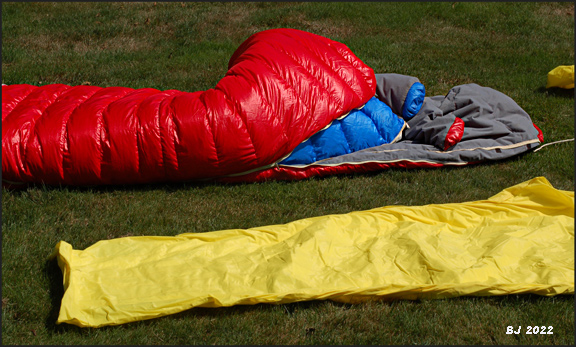 .Jack Stephenson, founder of Warmlite,
was an aerospace engineer who was an Innovator totally ready to
throw out conventional wisdom about how to keep warm in a sleeping
bag. Jerry Wigutow knew Jack. Above is a picture of a Warmlite
"Triple Bag," Warmlite's best-known bag. It was introduced
in about 1972, about the same time Wigutow introduced his lamilite
bags. However, unlike Wiggys, Warmlite uses down in its very unique
design.
.Jack Stephenson, founder of Warmlite,
was an aerospace engineer who was an Innovator totally ready to
throw out conventional wisdom about how to keep warm in a sleeping
bag. Jerry Wigutow knew Jack. Above is a picture of a Warmlite
"Triple Bag," Warmlite's best-known bag. It was introduced
in about 1972, about the same time Wigutow introduced his lamilite
bags. However, unlike Wiggys, Warmlite uses down in its very unique
design.
*****************************************************************************************************
User comments about the Wiggy's
Superlight bag pictured at top of this page:
The Wiggy's bag has a roomy
cut, which I like. The interior has a nice drape despite it not
being a non-differential down bag like the blue Holubar bag. I
do not like the hood very much; here the lamilite has trouble
cuddling close to your face, not a problem when temps are warm,
but when temps approach its rated zero degrees F it doesn't block
out the frigid air very well. A collar would help a lot. Lacking
that, when it's really cold, wear a good stocking cap and a sweater
or stout turtleneck.
In my opinion, Wiggy's bags
are excellent for use where their substantial bulk is not an issue.
Examples include horse packing, river trips, car camping, backyard
camping (!), boat camping, Vanlife,and more. For backpacking;
however, the Wiggy's bags are far too bulky; I had a similar issue
with the Warmlite Triple bag that I once owned. Below is a picture
of me trying to stuff that Wiggys Superlight bag into its stuff
sack (I gave up on it!): 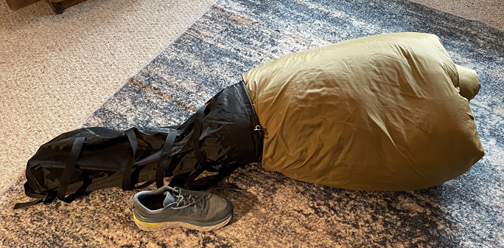
Link back to Alphabetized List of Gear Pioneers
Link
to my pages about Gerry Cunningham
Link
to my pages about Holubar Mountaineering
Link
to my pages about Warmlite and its founder Jack Stephenson
Page Last
Revised: August 25, 2023
 lite.
All three of these pioneers used down in their sleeping bags and
other products. Wiggy is 81*, and so was younger than these other
pioneers, but of these pioneers, only Jerry Wigutow is still living.
He's been based in Grand Junction, Colorado for many years. I
would love be able to post a picture of him from the 1970s, the
time period when he began selling his lamilite sleeping bags.
If anyone has a picture like that, please send it to me (brucej@Oregonphotos.com).
(*81 as of 2023). My picture of him is fairly current.
lite.
All three of these pioneers used down in their sleeping bags and
other products. Wiggy is 81*, and so was younger than these other
pioneers, but of these pioneers, only Jerry Wigutow is still living.
He's been based in Grand Junction, Colorado for many years. I
would love be able to post a picture of him from the 1970s, the
time period when he began selling his lamilite sleeping bags.
If anyone has a picture like that, please send it to me (brucej@Oregonphotos.com).
(*81 as of 2023). My picture of him is fairly current. Re:
the Wiggys Superlight, I have never tried to sleep in it anywhere
close to its rated 0 degrees F. In fact, I am dubious of that
claim.
Re:
the Wiggys Superlight, I have never tried to sleep in it anywhere
close to its rated 0 degrees F. In fact, I am dubious of that
claim. Above is a chart developed by major maker Sierra
Designs. It's taken from their 72-73 winter catalog. To Sierra
Designs a winter bag good to 5 above zero requires 8-9 inches of loft, as
in their model 200.
Above is a chart developed by major maker Sierra
Designs. It's taken from their 72-73 winter catalog. To Sierra
Designs a winter bag good to 5 above zero requires 8-9 inches of loft, as
in their model 200. .Jack Stephenson, founder of Warmlite,
was an aerospace engineer who was an Innovator totally ready to
throw out conventional wisdom about how to keep warm in a sleeping
bag. Jerry Wigutow knew Jack. Above is a picture of a Warmlite
"Triple Bag," Warmlite's best-known bag. It was introduced
in about 1972, about the same time Wigutow introduced his lamilite
bags. However, unlike Wiggys, Warmlite uses down in its very unique
design.
.Jack Stephenson, founder of Warmlite,
was an aerospace engineer who was an Innovator totally ready to
throw out conventional wisdom about how to keep warm in a sleeping
bag. Jerry Wigutow knew Jack. Above is a picture of a Warmlite
"Triple Bag," Warmlite's best-known bag. It was introduced
in about 1972, about the same time Wigutow introduced his lamilite
bags. However, unlike Wiggys, Warmlite uses down in its very unique
design.